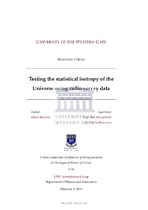Testing the statistical isotropy of the universe using radio survey data
Abstract
The Cosmological Principle forms part of one of the most fundamental hypotheses
of modern Cosmology. So it is very important to assess whether it holds true using
observational data, or whether it consists of a mathematical simplification. We probe
the statistical isotropy of the Universe using the existing radio continuum data, by
means of a local variance estimator. In order to investigate this, we analyse the number
count variance of the radio catalog by looking at patches of approximately 10,
15, 20 & 25 degrees in radii, and thus comparing it to mock catalogs which reproduce the
matter density power spectrum, as well as the same sky coverage of the real data.
We establish criteria for accepting patches that have more than 90%, 70% & 50% of
their pixels not masked. We make use of the NRAO VLA Sky Survey (NVSS), whose
operational frequency is 1.4 GHz. We perform statistical tests for detecting possible
departures from statistical isotropy using galaxy number counts with flux limits of
20 < SNVSS < 1000 mJy. We also compare the real data to the mock catalogs of the
radio data in order to assess the statistical significance of our results. We use the
local variance estimator for testing the statistical isotropy of our data sample. We
find that the statistical properties of our sample are in reasonable agreement with
the standard cosmological model. The mean of the distribution for the data falls
well within the 95% confidence interval of the average of the simulated mocks. For
all the radii and acceptance criteria for the patches, we found no significant deviations
beyond those allowed by the standard model. As expected there were no
large discrepancies between our mocks and the data. The results are consistent with
statistical isotropy.

